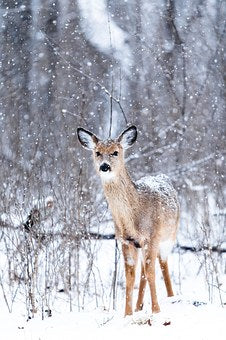Michael Schlegel, Ph.D., PAS, Dipl. ACAS-Nutrition
Sr. Nutritionist, Wildlife & Small Ruminant Technical Solutions Print
Feeding your deer herd during and after rut in the fall and winter sets bucks, does, and fawns up for success the following year. With less daylight in the fall and winter, the deer may not be seen at the feeders, but they will utilize the nutrition if available.
Feeding Bucks in the Winter
Even though bucks are in hard rack and achieved their antler size for the year, they can lose 10-30% of their body weight due to increased activity and decreased food intake during the rut and subsequent winter. Feeding bucks during the fall and winter allow bucks to regain the weight they may have lost during the rut.
Bucks entering the spring in good body condition can utilize the nutrients they consume for antler growth rather than merely regaining the weight they lost the previous season. Fall and winter feeding does not need to be the high protein diets that allowed the deer to reach their genetic potential for antler growth. A well-balanced diet of 16% protein and added fat and minerals to support reproduction is of greater benefit than just corn during this time of year.
Feeding Does Through Winter
After a summer of producing milk for one to three fawns, a doe’s body weight and body condition has decreased. Just like the bucks, regaining the lost weight and condition is critical for reproductive success and for surviving the winter.
A study conducted at Washington State University in mule deer showed that digestibility energy intake the month prior to the breeding season impacted pregnancy rate and rate of twinning. Additionally, does with greater body fat prior to the breeding season had greater rates of twinning.
Benefits of Winter Feeding for Fawns
Does in good body condition during gestation were found to produce heavier and a greater number of fawns than does in poor body condition.2 Fawns with low birth weights have a greater chance of mortality within the first week of life.3 Additionally, researchers are evaluating the link between the food available to does during gestation and their fawns’ future performance.
Fawns born early and late summer may benefit from fall feeding. The fawns born early in the summer are just being weaned in early fall and depending on forage availability would benefit from supplemental feeding. Likewise, fawns born late in the summer may benefit from supplemental feeding in the fall and winter to achieve an adequate body size to survive the winter.
In both cases, the fawns have watched their does consume the supplemental feed and have started nibbling it as well. Weaning is a period of stress and having an additional source of nutrition, like supplemental feed, supports the fawns’ needs during this period of transition.
The importance of supplemental feeding in the spring and summer to support antler growth is a common practice. Continuing to feed deer in the fall and winter is also important to support the nutrient requirements of all classes of deer to support their body weight and body condition to continue to have a successful program the following year.
1 Tollefson, T.N., L. A. Shipley, W.L. Myers, D.H. Keisler, N. Dasgupta. 2010. Influence of summer and autumn nutrition on body condition and reproduction in lactating mule deer. Journal of Wildlife Management 74(5):974-986.
2Verme, L.J. 1963. Effect of nutrition on growth of white-tailed deer fawns. Trans. N. Am. Wildl. Nat. Res Conf. 28:431-443.
3Carstensen, M., G.D. Delgiudice, B.A. Sampson, and D.W. Kuehn. 2009. Journal of Wilflife Management 73(2):175-183.
Click Here to Shop Purina Deer Blocks























